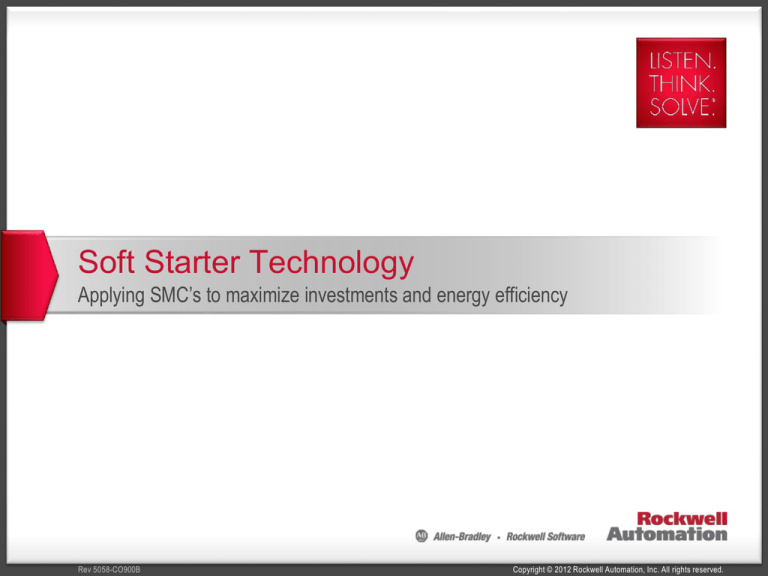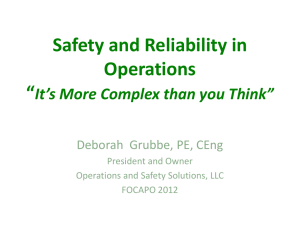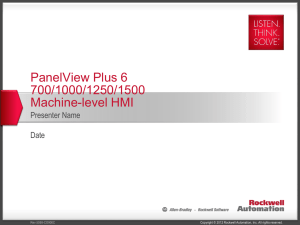
Soft Starter Technology
Applying SMC’s to maximize investments and energy efficiency
Rev 5058-CO900B
Copyright © 2012 Rockwell Automation, Inc. All rights reserved.
RAOTM - Topic
Title:
Practical applications of Soft Starter technology for improved performance
and energy management
Description:
Increase your technical competency and understanding of the latest Soft
Starter technology, and find out how SMC's can be applied to maximize your
investment and energy efficiency. This session will include a brief overview
on technology, recent advancements, application examples and
considerations, use of the SMC Application Wizards, and an overview of the
Allen Bradley SMC portfolio.
Copyright © 2012 Rockwell Automation, Inc. All rights reserved.
Agenda
Understand Soft Starter Technology
Recent Advancements
Application Examples and Considerations
Application Wizards
Allen Bradley SMC Portfolio
Copyright © 2012 Rockwell Automation, Inc. All rights reserved.
3
AC Motor Control Basics
SCPD
SCPD
SCPD
Optional
Isolation
Contactor
Contactor
AC / DC / AC
Converter
Overload
DOL
VFD
SMC
M
M
M
3
3
3
Basic
Advanced
Copyright © 2012 Rockwell Automation, Inc. All rights reserved.
4
Reduced Voltage Starter Background
Pre 1980’s RVS Types
Today’s RVS
Auto Transformer
Solid State
Part Winding
Voltage
Wye-Delta (Star-Delta)
Primary Resistance
Primary Inductance
Wound Rotor
RVS
controlled through use of SCR’s
(Silicon Controlled Rectifiers)
6 Back to Back SCR’s
SCR triggered
“ON” by energizing the Gate
Microprocessor monitors and controls when
SCR’s fire
Gate
SCR
Electromechanical Solid State
Copyright © 2012 Rockwell Automation, Inc. All rights reserved.
5
Solid State Starting Basics
SCR Control
A. Using SCR’s in an “opposed” (back to back) configuration, the full sine wave of the
B.
AC power can be controlled.
By controlling when an SCR is fired in the cycle, the output voltage can be
controlled. The result is sometimes called a Notch.
Gate Signal
Gate
SCR
VOUT
VIN
A
B
Copyright © 2012 Rockwell Automation, Inc. All rights reserved.
6
Soft Motor Starting Basics
Typical Motor Starting Curve
Starting Torque
(Lock rotor torque)
Full Voltage
Starting Characteristics
Starting Current
~6xFLA
Break-down
torque
Pull-up torque
180%
Full load
torque
100%
0
Speed -%RPM
100%
High starting torque can cause damage to the mechanical system.
High current can cause problems in the electrical system
Copyright © 2012 Rockwell Automation, Inc. All rights reserved.
7
Soft Motor Starting Basics
Physics of Reduced Voltage and Motor Torque
If you reduce voltage by 50%, the result is a 75% reduction in motor torque.
(.5)2 = .25 or 25% of Locked Rotor Torque
180%
Percentage
of Full Rated
Torque
Full Voltage Torque
100%
Reduced Voltage Torque
0
Percentage of Full Speed
100%
Copyright © 2012 Rockwell Automation, Inc. All rights reserved.
Soft Motor Starting Basics
Example
72%
%FLA
300%
(ftlb)
Torque
100%
510%
100% Voltage
(amps)
600%
85% Voltage
Full Load
25%
50% Voltage
0
Current
Torque
Speed -RPM
100%
Torque required
by the load
Copyright © 2012 Rockwell Automation, Inc. All rights reserved.
9
Reasons for Soft Motor Starting
• Minimize mechanical damage of system components and product
•
•
•
Belts, Gears, Drive Shafts and Keyways
Reduced Product Spillage
Water Hammer and Mechanical Vibration
• Better Energy “Management”
•
Limit in-rush current
– Optimize the size of transformers/generators/switch gear
•
•
•
Meet Power Company Requirements / Rebate programs
Manage Control under Power Distribution Limitations
Energy Cost Reduction (Peak Demand Charges)
Copyright © 2012 Rockwell Automation, Inc. All rights reserved.
10
Agenda
Understand Soft Starter Technology
Recent Advancements
Application Examples and Considerations
Application Wizards
Allen Bradley SMC Portfolio
Copyright © 2012 Rockwell Automation, Inc. All rights reserved.
11
Electromechanical vs. Solid State
Solid State delivers greater flexibility
Allow for the starting current/torque to be optimized versus standard reduced
voltage starter types
Example Star-Delta reduced voltage starter is fixed at 300% current/33% Torque
Solid State insures minimal amount of energy to accelerate motor even if the load only
requires 25% torque.
SS eliminates transitions due to electromechanical limitations
Open or Closed transitions
Open disconnects motor from line voltage, Closed maintains connection to line
Both cause current surges during start
Starting Voltage Adjustment
Transition
Resulting Torque
Method
Range
Primary
Fixed Step/Steps
Closed
%Current Sqd
Resistance
Auto Xfmr
50/65/85%
Closed
25/42/72%
Wye-Delta
33%
Open or Closed
33%
Solid State
0 - 100%
Stepless
0 - 100%
Copyright © 2012 Rockwell Automation, Inc. All rights reserved.
12
Advantages of Solid State Control
• Enhanced Control Options
–
–
–
–
Advanced Start/Stop control
User Programmability and settings
Scalable setting for the critical nature of application
Local, Manual, Automatic Modes
• Inherent Diagnostics
–
–
–
Current, Voltage, Power and Energy Monitoring/protection
Faults and Alarms (some based on real time clock)
Controller Event logs and Snapshot (what happened right before a fault)
• Lowest Installed Cost with Network Integration
–
–
–
Ease of Communication Linkage (i.e. multi protocol, AOP’s)
Localized I/O and Control
Wire Reductions
Copyright © 2012 Rockwell Automation, Inc. All rights reserved.
13
2 Phase Vs. 3 Phase Control
Comparison
2 Phase Control Advantages
Lower initial cost
Smaller overall total size
2 Phase
2 Phase Control Disadvantages
Higher Peak Currents/Imbalance
3 Phase
Regardless of control methodology
Increased Heating
Increased Vibration during Starting
3 Phase control provides superior performance on every start!
Copyright © 2012 Rockwell Automation, Inc. All rights reserved.
Advances in Starting/Stopping Modes
SMC-50 “Patented” Linear Acceleration Starting Mode
• Simplest Starting Mode
• Lowest starting current profile per start
•
Regardless of loading condition
• Ideal for any application
• Provides control over both torque and speed
•
•
Unmatched motor starting performance
Selected start time closer to actual than any other stating method*
Copyright © 2012 Rockwell Automation, Inc. All rights reserved.
Starting Performance – Comparison
Linear Accel vs. Traditional Soft Start: Centrifugal Pump Load
High Torque Pulse/Surge and
water hammer
2 Sec/Div = ~10 Sec
Higher Peak Current
Current more stable and
less disruptive to power
system
Time
Parameter Settings: = Start Time: 10 second
Copyright © 2012 Rockwell Automation, Inc. All rights reserved.
16
Starting Performance – Comparison
Linear Accel vs. Traditional Soft Start: High Inertia Load
Torque Pulse/Mechanical Wear and Tear
2 Sec/Div = ~10 Sec
2 Sec/Div = ~6 Sec
Higher Peak Current
Current more stable and
less disruptive to power
system
Time
Parameter Settings: =Start Time: 10 second
Copyright © 2012 Rockwell Automation, Inc. All rights reserved.
17
SMC Soft Starters
Power and Energy Management
Green Initiatives
Allow users to qualify for Energy focused based rebates and discount programs
Help reduce energy consumption and waste
Facility wide information enablement via Intelligent Motor Control
Sustainability and Sustainable Production
Deliver a return on investment with scalable products
Reduced downtime and maintenance costs
Energy Savings
Reduce the total “amount” of energy consumed
(Energy Saver in SMC-50)
Reduce the total “cost” of energy
Copyright © 2012 Rockwell Automation, Inc. All rights reserved.
Soft Starters and Energy Management
Reduction of the peak inrush of a motor (i.e. peak current)
Reduces the peak demand charges
Charges are determined by utility based on the peak energy usage
Advantages of Controlled Demand
Allows for the facility to optimize/maximize distribution
Smaller genset’s or transformers (incl. feeders… wires etc.)
Allows the power company optimize/maximize distribution
Possible reduced installation cost based on system demands
Scalable Performance
SMC Flex and SMC-50 Provide advanced Power and Energy Monitoring
Measurement it = manage it
Visibility = helps provide business case support for future process and product improvements
Copyright © 2012 Rockwell Automation, Inc. All rights reserved.
Agenda
Understand Soft Starter Technology
Recent Advancements
Application Examples and Considerations
Application Wizards
Allen Bradley SMC Portfolio
Copyright © 2012 Rockwell Automation, Inc. All rights reserved.
20
Motor Starting Comparison
SMC Soft Start
Full Voltage (DOL)
Simplest Starting Solution
Simple Starting and Stopping
Full torque applied to motor
Mechanical wear
~6x inrush current
Peak demand charges
Limited Control at various speeds
Reduced torque and current during
starting
Limited Functionality
Unless used with
advanced Overload
Simple to adjust and setup
Reduced installation costs
Smaller footprint
No need for harmonic/EMC
mitigation
Highly efficient when running at full speed
Energy Saver Performance for light loads
Up to 15 different starting modes
Finite Mechanical Life
Contacts will wear out
No Starting Choices
VFD/Drive
• Complete Continuous Control at any
Speed
• Full torque at any speed without
sacrificing current
• Highly efficient motor and application
performance
• More complex setup and install
• Larger footprint
• Impact on Power Quality
• Application Considerations
• Motors types
• Lead Lengths
• Wire Type
• Ambient Conditions
• Unlimited Starting possibilities when
sized properly
Copyright © 2012 Rockwell Automation, Inc. All rights reserved.
Selecting a Starting Method
When do I specify a drive versus a soft starter?
Speed Control is required
Consistent Acceleration and Deceleration (New SMC-50 exception)
High starting torque required
Continuous Feedback (critical position control)
Custom starting and stopping maneuvers
Faster stopping with Dynamic braking options
Drive can hold rotor at zero speed
Undersized or closely matched motor or power source
Copyright © 2012 Rockwell Automation, Inc. All rights reserved.
22
Why Use SMC Controllers?
Minimize Operating Costs, Reduce Down time
• Problem:
–
Belts, gears and machinery can be damaged by across-the-line starting
Breakdown Torque
180%
High torque can cause
physical damage to the
mechanical system.
100%
Percentage
of Full Load
Torque
0
Percentage of Full Speed
100%
• SMC:
–
Lengthens system life by reducing mechanical stress during starting– Reduces DOWN Time
• Helps reduce/eliminate PMO on equipment
• No need to replace damaged parts
• Minimal production loss
Copyright © 2012 Rockwell Automation, Inc. All rights reserved.
23
Why Use SMC Controllers?
Minimize Operating Costs, Reduce Down time
• Problem:
–
–
Power company restrictions on incoming line current, or you pay the penalty
Weak power lines cannot handle high inrush currents, causing brown outs or excessive line
disturbances, which in turn cause other processes to shut down
600%
Percentage
of Full Load
Current
100%
• SMC Solution:
0
100%
Percentage of Full Speed
Current Limit starting minimizes the amount of inrush current, meeting power company
restrictions and lowering peak demand charges
– Process shut down and brown outs are minimized by reducing the amount of current drawn
during starting
–
Copyright © 2012 Rockwell Automation, Inc. All rights reserved.
24
How to apply SMC Controllers
Determine the main reason for using reduced voltage?
Mechanical?
Power Limitations?
Simplicity?
Select the best solid state control mode
•
•
•
•
•
•
•
Soft Start
Soft Stop
Current Limit
Soft Start/CL with Kick Start
Pump Control
Torque Control
Linear Acceleration/Deceleration
Special Modes
• Dual Ramp
• Full Voltage
• Slow Speed
• Custom Starting Profiles
• Smart Motor Braking
• Combination of profiles
Copyright © 2012 Rockwell Automation, Inc. All rights reserved.
25
Standard Starting Methods
Current Limit
Primarily used to limit line disturbances
Constant or very lightly loaded motor
Good on high inertia applications
Bandmills, Fans, Centrifuge, Ball Mill, Washers………
Soft Start
Primarily used to limit mechanical stress
Constant or exponentially increasing loads
Compressors, Pumps, Conveyors
Soft Start/Current Limit with Kick Start
Kick Start is needed to overcome static condition
Example: Cold system components, loaded conveyor
Full Voltage
Not a common Starting mode.
» NOTE: Full voltage required to accelerate the motor may be a sign of
other problems (i.e. Initial Torque of > 90%)
Used as a Solid State Contactor for High cycle rates
Copyright © 2012 Rockwell Automation, Inc. All rights reserved.
26
Standard Starting Methods
Pump Control
Legacy version of torque control optimized for centrifugal loads
Simple to apply but some considerations
Exponentially increasing load such as Compressors, Pumps, Conveyors
Torque Control
Similar to Pump Control performance but applicable for all load types
More difficult to apply but yields higher level of performance
Linear Acceleration/Deceleration
Simplest starting, lowest current , most consistent starting time per start regardless of load
Copyright © 2012 Rockwell Automation, Inc. All rights reserved.
27
“Pump Control” in SMC-Flex & SMC-50
Designed for Centrifugal Pumps
Applications lightly loaded at zero speed
Reduces surges (water hammer) caused by uncontrolled acceleration and deceleration
Can eliminate the need for specialized flow control valves
Ease of pump configuration
Provides control without the use of sensors or feedback devices
“Pump Control” Compared to Linear Acceleration
No advantage, other than legacy migration
“Pump Control” Compared to Torque Control
Easier to set up and optimized for centrifugal pumps
Not intended for Positive Displacement Pumps
Full Load required at zero speed
Variable Speed typically required to control flow
Copyright © 2012 Rockwell Automation, Inc. All rights reserved.
28
SMC-Flex & 50 Pump Control
DOL
Start
Excess
energy/power
Torque
Full
Load
Soft Start
Pump Start
Pump System
Speed
Full Speed
Copyright © 2012 Rockwell Automation, Inc. All rights reserved.
29
SMB™ Smart Motor Braking
SMC Flex and SMC-50
The SMB™ Smart Motor Braking is designed to stop a motor quickly
No additional hardware or feedback devices are required
Automatic zero speed shut off is integrated into the controller
Copyright © 2012 Rockwell Automation, Inc. All rights reserved.
30
SMB™ Smart Motor Braking
SMC Flex and SMC-50 Considerations
How fast do you want to brake?
Rule of thumb: It will take you at least 1.5 times as long to brake a
motor as it will to start (3 to 4 times is more typical)
How much power can you use for braking?
Rule of thumb: Anything more than about 300% can play havoc with
power systems and cause nuisance tripping or worse.
Can the power system handle the demands of braking current for the
entire duration of the stop?
How consistent does the brake time need to be?
A good power supply is critical to consistent braking
Good line Voltage regulation is the key to successful braking!
Copyright © 2012 Rockwell Automation, Inc. All rights reserved.
31
SMB™ Common Concerns/Questions
Braking is hard on the motor?
True, Braking… regardless of the method, is hard on the motor windings
Noise is common during braking?
True, moans and groans of all kinds can be heard in a motor during braking
Braking produces increased Harmonic distortion?
True, the SMC produces some harmonic distortion during starting and stopping, however the
levels are insignificant (typically < 10% of the fundamental)
SMB is a good alternative for Critical braking?
False, SMB is not intended to be used for E-Stop scenarios. To many variables are involved
which can alter the performance of this feature
The SMB option damages motors?
False, Braking is hard, but we can not create more energy then what the motor demands.
Motor damage is typically caused by incorrect settings or normal wear and tear
Smart Motor Braking is an exact science?
False, Most applications are dialed in via trial and error
Copyright © 2012 Rockwell Automation, Inc. All rights reserved.
32
SMC
Special Application Considerations
Multi-Motor Applications
Mechanically Coupled (Transmission, direct gear drive, Conveyors)
Single SMC for multiple motors
Separate Overload protection required
Not Mechanically Coupled (No physical connection)
Separate SMC’s per motor
One SMC Not Recommended
Reduced Performance and adjustability
Too much variability in motor characteristics
Cost advantage with Adj.Freq. Drive, but less with SMC
Copyright © 2012 Rockwell Automation, Inc. All rights reserved.
33
SMC
Special Application Considerations
Power Source Sizing Guidelines
Ideally, the source would be sized for a full voltage start. (Somewhat impractical today)
When sizing for use with a generator it is critical that the generator is able to stay in proper
regulation under starting or braking loads.
Rule of thumb: Avoid sizing the supply for anything less the 300% of the motors FLA .
SCR Fusing for SCR Protection (Very Fast Acting Semiconductor type fuse)
Limited usefulness with SMC-Flex and SMC-3, due to bypass operation
Use is not suggested in High Inertia, Braking, or Pump stop applications (Applications with
Start times > 30 seconds) due to potential for nuisance tripping
Can be used to achieve Type 2 Coordination in some cases
See SMC Wizard – Short Circuit Protection (SCPD) Wizard for further guidance
Copyright © 2012 Rockwell Automation, Inc. All rights reserved.
34
SMC
Special Application Considerations
Power Factor Correction Capacitors
Line side only - locating load side can damage the SCR
Ideally PFCC are brought in with up-to-speed contact
Dynamic Correction can be responsible for nuisance line fault’s
Transient/Cyclic Spikes of Current Due to Load Variation
Examples: Rock Crushers, Wood Chippers, Band Saws, etc.
With the SMC-Flex & SMC-3, Spikes 120% of controller max frame rating causes the
bypass to drop in and out…NOTE: If this is happening a lot, the SMC is likely under sized for the
application
Insure the FLA adjustment/programming is correct for the motor operation
SMC-3 and Soft Stop
For best operation try to size SMC-3 mid range per Selection Guide/Catalog
Copyright © 2012 Rockwell Automation, Inc. All rights reserved.
35
Sizing the starter for the application
Selection guides are correct for 90% of applications (Pumps, Fans, Compressors)
Simply choose based on voltage, horsepower, current and insure that the motor
FLA fits the SMCs operating range
10% of applications may require a closer look
Application Analysis: Load with potential high starting inertia or minimal load
Flywheel, chippers, grinders, braking, retrofits, running vs. starting req. etc.
Thermal Analysis may be required to determine proper size for the following:
Extended starting or stopping times (>30 sec)
Aggressive Duty Cycle (> 10 times/hr)
Operation in elevated (above 50C) ambient temperatures
LRA > 600% (i.e. High efficiency motors, NEMA Design A)
Solution to Assist: SMC “Estimation Wizard”
Copyright © 2012 Rockwell Automation, Inc. All rights reserved.
36
Agenda
Understand Soft Starter Technology
Recent Advancements
Application Examples and Considerations
Application Wizards
Allen Bradley SMC Portfolio
Copyright © 2012 Rockwell Automation, Inc. All rights reserved.
37
SMC Application Wizards
Why use the Wizards (eTools)?
To provide a better Estimation to the applicability of a SMC-3, SMC Flex and SMC50 product to a given set of motor & load operating requirements.
Copyright © 2012 Rockwell Automation, Inc. All rights reserved.
SMC Application eTool’s
Thermal Wizard
Used for simple/quick analysis of SMC
capabilities from a thermal perspective
Short Circuit Protection Device
Used to guide selection of branch
circuit protection components
i.e. fuse or circuit breaker size
bypass and isolation sizing
Application Wizard
Used for advanced modeling of the
complete system including SMC
thermal capabilities and motor/load
starting characteristics
Wizards Available from:
ProposalWorks “Tools” pull-down or from:
http://ab.rockwellautomation.com/Motor-Control/Soft-Starters/SMC-Flex#/tab6
Copyright © 2012 Rockwell Automation, Inc. All rights reserved.
SMC Application eTool’s
SMC Applications built for mobile
phones and tablets
Cross platform support with all
major mobile operating systems
iOS, Blackberry, and Android
HTML 5 based applications
Allows for ease of use and
updating
Can run like any standalone
mobile application
Almost fully offline capable
Do an App Search for Rockwell Automation
Copyright © 2012 Rockwell Automation, Inc. All rights reserved.
Agenda
Understand Soft Starter Technology
Recent Advancements
Application Examples and Considerations
Application Wizards
Allen Bradley SMC Portfolio
Copyright © 2012 Rockwell Automation, Inc. All rights reserved.
41
Solid State Power Control Portfolio
Performance / Functionality
SMC™-50
SMC™ Flex
SMC™ Dialog
SMC™-3
SSC
5
25
100
200
500
Ampere Rating (Line and Delta)
800
1000
1600
*Dialog supports line configuration only
Copyright © 2012 Rockwell Automation, Inc. All rights reserved.
Allen-Bradley
SMC Contemporary Offering
SMC™-3
Hybrid Power Structure
SMC™ Flex
Hybrid Power Structure
SMC™-50
Solid State Power Structure
Copyright © 2012 Rockwell Automation, Inc. All rights reserved.
43
SMC Family
Choosing a Power Platform
True Solid State
Hybrid Solid State
AC53-B
Smaller
Total Footprint
Less
External Wiring
Optimized Thermal
Management
Easy Product
Selection
Hybrid Solid State (Integral Bypass)
2 Thyristors per phase (6 total)
Thermal Mass
Small Stirring Fans
Integral Shorting or “Bypass” Contactor
True Solid State
2 Thyristors per phase (6 total)
Larger finned heat sinks & fans
Optional external bypass contactors
Lower Total
Installed Cost
Ability to replace contactor
Ability to size contactor AC1 or AC3
AC53-A
Ideal for Harsh
Environmental
Conditions
Higher SCCR
ratings
Phase
Rebalance/Energy
Saver Capability
Higher
operations/hour
Scalable Thermal
Ratings
Copyright © 2012 Rockwell Automation, Inc. All rights reserved.
SMC Family
Choosing a Power Platform
Internal Bypass (SMC-3, SMC Flex)
Solid State (SMC-50, SMC Dialog, SMC Plus)
Ideal for small spaces
Ideal for critical performance in
tough environmental conditions
Smallest total footprint
Easy selection and application
Allows for Specialized Control
Lowest total installed cost
External Bypass offers
operational flexibility and
redundancy
Hybrid Power Structure
Solid State Power Structure
Copyright © 2012 Rockwell Automation, Inc. All rights reserved.
45
SMC Family
Choosing the control for your application
Which control modes are required?
SMC-50, Flex & SMC-3
Soft Start
Soft Stop
Current Limit
Soft with Kick Start
SMC-50, SMC-Flex
Pump Control
Slow Speed
Dual Ramp
Full Voltage Starting
Smart Motor Braking
Linear Accel/Decel (SMC-50 Only)
Torque Control (SMC-50 Only)
The SMC Flex / 50 also offer power metering features as well as communication options
enhancing configuration, control and data collection capabilities!
Copyright © 2012 Rockwell Automation, Inc. All rights reserved.
46
SMC™-3 Overview
Compact Series
Hybrid design (internal bypass contacts)
Simplified DIP and Rotary Set-up
Din Rail Mountable through 85 amps
4 Starting/Stopping Modes
Soft-start, Soft-stop, Current Limit, Kick Start
Basic Diagnostics
Compact design provides 3 phase control, increased intelligence, and unmatched
performance. Motor and system diagnostics and an electronics overload with
adjustable trip class help reduce downtime and protect assets.
Hybrid Power Structure
Copyright © 2012 Rockwell Automation, Inc. All rights reserved.
SMC™-3 Overview
Line Ratings
Frame 1 (3 A, 9 A,16 A, 19 A, 25 A, 30 A, 37 A)
Frame 2 (43 A, 60 A, 85 A)
Frame 3 (108 A, 135 A)
Frame 4 (201 A, 251 A)
Frame 5 (317 A, 361 A, 480 A)
Delta Ratings
3 … 831 amps
Two line voltage ratings
200…480V or 200…600V @ 50/60 Hertz
Two control voltage
24V AC/DC or 100…240V AC
0…50°C Operating temperature
SMC-3 can be applied to both line and delta connected applications!
Copyright © 2012 Rockwell Automation, Inc. All rights reserved.
SMC™ Flex - Overview
Modular Class
Hybrid design (internal bypass contacts)
Built-In LCD and Keypad
9 Start/Stopping Modes
3 slow-speed modes
Smart Motor Braking
Enhanced Diagnostics and Protection functions
Modular design features 3 phase control, advanced intelligence, performance
and diagnostics, communications flexibility, modular control module/power
modules/fan assembly for a cost effective package.
Hybrid Power Structure
Copyright © 2012 Rockwell Automation, Inc. All rights reserved.
SMC™ Flex - Overview
Specifications
Line Ratings
5….1250 Amps
Delta Ratings
8…1600 Amps
Three Voltage Ratings
200 - 480V @ 50/60 Hz
200 - 600V @ 50/60 Hz
230 – 690V @ 50/60 Hz
Control Voltage Ratings
100-240 VAC or 24V AC/DC
Starting Modes
Soft-Start
With selectable Kick Start
Soft-Stop
Current Limit Start
With selectable Kick Start
Full Voltage
Preset Slow Speed
Linear Speed Acceleration
Feedback Device Required
Dual Ramp
Pump Control (optional)
0 - 50° C Operating Temperature
Copyright © 2012 Rockwell Automation, Inc. All rights reserved.
SMC™-50 Product Overview
Scalable Series
Solid State Power Structure
NO Integral bypass like SMC-3 or SMC-Flex
Built-In HIM Cradle and PC port
15 Start/Stopping Modes
3 slow-speed modes
Smart Motor Braking
Advanced Diagnostics and Protection functions
Full power and energy management, Real Time Clock, Event Log
Designed for customer flexibility – 3 phase control and scalable options help
maximize the total motor control investment. Advanced monitoring and protection,
superior communication capabilities and energy saver modes help increase
operating efficiencies and reduce downtime.
Solid State Power Structure
Copyright © 2012 Rockwell Automation, Inc. All rights reserved.
51
SMC™-50 Product Overview
Benefits of a Fully Solid State Power Structure
(no integral bypass)
Improved performance in high vibration applications
Performance not impacted by environmental debris
Longer life (no mechanical life limits)
Scalable thermal ratings
Higher SCCR ratings
100 Ka Fuses
65 Ka Breaker
Copyright © 2012 Rockwell Automation, Inc. All rights reserved.
52
Thank You!
Find More Information on SMC Products
Visit us @ WWW.AB.com
Follow ROKAutomation on Facebook & Twitter.
Connect with us on LinkedIn.
www.rockwellautomation.com
Rev 5058-CO900B
Copyright © 2012 Rockwell Automation, Inc. All rights reserved.
Back-Up Slides
Follow ROKAutomation on Facebook & Twitter.
Connect with us on LinkedIn.
www.rockwellautomation.com
Rev 5058-CO900B
Copyright © 2012 Rockwell Automation, Inc. All rights reserved.
SMC™-50 Modes of Operation
Starting Modes
Soft Start
Current Limit w/ Kick Start
Pump Control
“Enhanced” Slow Speed: 1% to 15%
Patented Sensor-less Linear Acceleration*
Consistent ramp up time (no tachometer
required)
Optimizes energy consumption
Torque Control
Full Voltage
Dual Ramp w/ Kick Start
Stopping / Specialty Modes
Coast
Soft Stop
Smart Motor Braking (SMB)
Linear Deceleration
External Braking Control
Pump Control
Motor Winding Heater
Energy Saver
Phases back voltage sensing lighter loads
Emergency Run
*SMC Flex provides Linear Acceleration Start, however it requires a tachometer for speed feedback
Copyright © 2012 Rockwell Automation, Inc. All rights reserved.
55
SMC™-50 Modes of Operation
Linear Speed
“Patented” Sensor-less Linear Acceleration Starting Mode
•
Accomplished via Advanced Motor Speed Estimation Algorithm
–
–
•
Simplest to Setup
–
–
•
No external feedback required - reduces cost and potential for failure
Provides exacting motor acceleration control under varying load conditions
2 Parameters Required to configure: Ramp Time and Initial Torque (used as reference)
Reduces/eliminates the need for the Dual Ramp mode
Always uses the minimum amount of energy needed to accelerate the motor in the time requested
(regardless of the loading condition)
Copyright © 2012 Rockwell Automation, Inc. All rights reserved.
56
SMC™-50 Modes of Operation
Torque Control
Torque Control can be used to control the maximum torque developed by the motor
independent of motor speed
Provides a torque ramp from an initial starting torque level to a maximum torque level
Mode also provides simple starting performance (Kick start available as an option)
Controlling torque does not allow control over speed of acceleration like Linear Accel.
Torque Control algorithms are useful for basic applications (pumps, compressors)
Basic Setup Parameters:
Ramp Time, Starting Torque, Max Torque(M), Rated Torque(M) and Rated Speed Settings(M)
(M) = motor rated value
Copyright © 2012 Rockwell Automation, Inc. All rights reserved.
57
SMC™-50 Modes of Operation
Comparison Example
Linear Accel vs. Torque (Pump) Start: Pump Load
2 Sec/Div
= 10 Sec total
2 Sec/Div
= 5 Sec total
Higher Peak Current
Time
NOTEs:
- Actual Start time difference of Linear versus torque mode
- Smoother torque curve for Linear versus torque mode
- Lower peak current with Linear Acceleration mode
Parameter Settings: =Start Time: 10 second
Motor load = approx 65% of FLA
Copyright © 2012 Rockwell Automation, Inc. All rights reserved.
58
SMC’s Differentiated by Innovation
Broadest offering of Features/Performance/Functionality in a Soft Start
Advanced Starting/Stopping Performance (Linear Mode)
“True” 3 Phase Control
Solid State or Hybrid Performance and Reliability
Simple to Advanced Fault, Power, and Energy Monitoring
High Fault SCCR ratings with Fuses and Standard Breakers
Special Modes
Slow Speed, Motor Winding Heater, Energy Saver, Phase Rebalance, DeviceLogix
Standard features cover multiple dedicated devices
Improved Troubleshooting, Diagnostics Accuracy and time stamping
Power Monitors, Scopes, ETM’s, Motor Winding Heaters, DC Brake… etc.
Standard Open and Enclosed offerings
Copyright © 2012 Rockwell Automation, Inc. All rights reserved.









